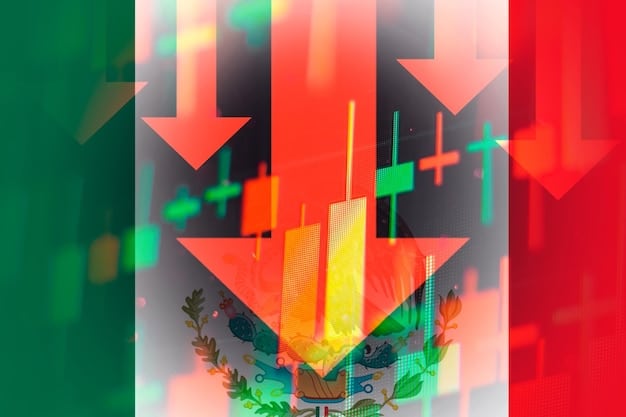US Interest Rate Hikes: Impact on Mexican Exports in 6 Months

US interest rate hikes are anticipated to exert varied pressures on Mexican exports over the next six months, potentially leading to a nuanced realignment of trade flows and economic strategies between the two nations.
The intricate dance between global economic powers often sees policy decisions in one nation echo across borders, fundamentally reshaping trade landscapes. One such critical ripple effect is observed in The Impact of US Interest Rate Hikes on Mexican Exports: What to Expect in the Next 6 Months. As the Federal Reserve adjusts its monetary policy, the ramifications for Mexico’s robust export sector become a focal point of economic analysis, demanding a closer look at the mechanisms and potential outcomes shaping this vital economic relationship.
Understanding the Mechanism of US Interest Rate Hikes
Delving into the direct and indirect pathways through which US interest rate adjustments influence Mexican exports requires a foundational understanding of monetary policy and its interconnectedness with international trade. When the Federal Reserve, the central bank of the United States, decides to increase its benchmark interest rate, typically the fed funds rate, it triggers a chain reaction that reverberates through the global financial system, including Mexico’s economy.
Primarily, a hike in US interest rates typically strengthens the US dollar. This occurs because higher interest rates make dollar-denominated assets, such as US Treasury bonds, more attractive to foreign investors seeking higher returns. The increased demand for the dollar drives up its value relative to other currencies, including the Mexican Peso. A stronger dollar makes Mexican goods and services more expensive for US buyers, potentially dampening demand for Mexican exports. This direct exchange rate effect is often the first impact noticeable by businesses engaged in cross-border trade.
Direct Financial Channels and Trade Costs
The cost of borrowing for Mexican businesses, especially those relying on dollar-denominated loans for their operations or expansion, can also be affected. Higher US rates translate into higher USD borrowing costs, even for Mexican entities. This escalation in financing expenses can reduce profitability for export-oriented firms, potentially hindering investment in new capacity or technology that could enhance competitiveness. Furthermore, for companies that import raw materials or components priced in dollars, a stronger dollar also increases their input costs, further squeezing margins.
- Increased cost of dollar-denominated loans for Mexican businesses.
- Higher input costs for Mexican exporters importing US-made components.
- Potential reduction in foreign direct investment (FDI) into Mexico from the US, as capital might be reallocated to higher-yielding US assets.
Moreover, the broader US economic context plays a crucial role. Interest rate hikes are often implemented to curb inflation by slowing down economic activity. A slowdown in US economic growth, even if modest, can lead to reduced consumer spending and business investment, which directly impacts the demand for Mexican goods. Given that the US is Mexico’s largest trading partner, absorbing roughly 80% of its exports, any contraction in US demand can have significant implications for Mexican producers across various sectors.
Understanding these intricate connections is vital for forecasting the trajectory of Mexican exports. It’s not just about the immediate cost of goods but encompasses a broader economic ecosystem where monetary policy ripples create both challenges and, potentially, opportunities for adaptation.
In essence, US interest rate hikes initiate a complex interplay of currency valuation, borrowing costs, and aggregate demand shifts that collectively influence the competitiveness and volume of Mexican exports. Businesses and policymakers in Mexico must navigate these dynamics with strategic foresight to mitigate adverse effects and capitalize on emerging opportunities.
Currency Fluctuations: USD Strength vs. MXN Volatility
The relationship between US interest rate hikes and the valuation of the USD against the Mexican Peso (MXN) is a cornerstone in understanding the export landscape. When the Federal Reserve raises interest rates, it signals a more attractive return on dollar-denominated assets. This higher yield draws capital into the US, increasing demand for the dollar and consequently strengthening it against other currencies, including the MXN.
A stronger US dollar makes Mexican products relatively more expensive for American consumers and businesses. For example, if a Mexican-made automobile costs 200,000 MXN, and the MXN weakens against the USD, that same car might effectively cost more dollars in the US market. This can reduce the competitiveness of Mexican exports, leading to lower sales volumes or pressure on Mexican exporters to absorb some of the exchange rate difference through reduced profit margins. This direct impact on price competitiveness is often immediate and widely felt across diverse sectors of the Mexican export industry.
Impact on Export Margins and Competitiveness
Mexican exporters, particularly those with tight margins or those producing goods with more elastic demand, can find themselves in a challenging position. They might choose to maintain their dollar prices to remain competitive, thus accepting lower profits when converting their earnings back into pesos. Alternatively, they could increase their dollar prices to preserve peso-denominated profits, risking a loss of market share to competitors from other countries or even to domestic US producers.
- Erosion of profit margins for Mexican exporters due to unfavorable exchange rates.
- Pressure to absorb exchange rate differences or risk losing market share.
- Increased cost of imported inputs for Mexican manufacturers, further impacting profitability.

Furthermore, the volatility of the MXN against the USD can create an environment of uncertainty, making it harder for Mexican exporters to plan future pricing strategies and manage foreign exchange risk. Businesses may need to invest more in hedging strategies to mitigate currency fluctuations, adding to their operational costs. This increased sensitivity to exchange rates underscores the delicate balance Mexican exporters must strike to remain viable in the international market.
While a depreciating peso might, in some theoretical scenarios, make exports cheaper and thus more attractive, the dominant effect when driven by US rate hikes is usually a net negative for Mexican exporters due to the combined factors of higher US borrowing costs, potential US demand slowdown, and the immediate impact on pricing. The interplay between USD strength and MXN volatility thus becomes a critical determinant of Mexican export performance in the short to medium term.
In the next six months, the continued strength of the USD driven by US interest rate policy is likely to present a persistent headwind for Mexican exports, forcing businesses to adapt by focusing on cost efficiencies, value-added products, and exploring diversification of their export markets beyond the US. The ability to navigate these currency dynamics will largely define the resilience of Mexico’s export sector.
Sector-Specific Vulnerabilities and Opportunities
The impact of US interest rate hikes on Mexican exports is not uniform; different sectors exhibit varying degrees of vulnerability and, in some cases, unexpected opportunities. Mexico’s export economy is diverse, encompassing automotive, electronics, agriculture, and manufactured goods, each with unique sensitivities to macroeconomic shifts.
The automotive sector, a cornerstone of Mexican exports, is particularly sensitive. It relies heavily on integrated supply chains with the US, often involving the cross-border movement of parts and finished vehicles. A stronger dollar makes these vehicles more expensive for US consumers, potentially leading to a dip in sales. Moreover, financing costs for consumers in the US might rise, further dampening demand for big-ticket items like cars. However, the deep integration of the North American automotive industry (under USMCA) means that some components manufactured in Mexico are essential for US-based final assembly, which could somewhat cushion the blow by maintaining a baseline demand.
Electronics and Agricultural Exports
Electronics manufacturing, another significant export, faces similar challenges. If demand for electronics softens in the US due to higher borrowing costs or economic slowdown, Mexican production destined for the US market will likely follow suit. However, some segments, like those tied to essential infrastructure or specialized industrial components, might show greater resilience. For instance, demand for servers or specific technological parts for US defense or critical industries might be less elastic to price changes caused by currency shifts.
- Automotive sector: High vulnerability due to consumer financing and price sensitivity.
- Electronics: Mixed impact, with essential components showing more resilience than consumer goods.
- Agriculture: Relatively stable due to essential nature, but sensitive to exchange rates and input costs.
Agricultural exports, while less susceptible to consumer financing costs, are directly affected by exchange rates and, critically, by the cost of inputs (fertilizers, machinery, etc.), many of which are dollar-denominated. A stronger dollar could make Mexican produce more expensive in the US, but the necessity of food can provide a buffer. Furthermore, specific agricultural products where Mexico holds a strong competitive advantage (e.g., avocados, berries) might maintain demand despite minor price increases due to their unique offerings and established market positioning.
Conversely, some sectors might find opportunities. For example, lower labor costs in Mexico, accentuated by a weaker peso, could make certain Mexican services or niche manufacturing processes more attractive to US companies looking to optimize costs, assuming their input costs are not disproportionately affected. Nearshoring trends, accelerated by supply chain disruptions and geopolitical factors, might also offer a silver lining. As US companies seek to reduce reliance on distant suppliers, Mexico’s geographical proximity and established trade agreements become increasingly appealing, potentially offsetting some of the negative impacts of currency fluctuations and interest rate differences.
Ultimately, the impact on Mexican exports is a nuanced picture, with core manufacturing facing headwinds, while essential goods and strategically positioned industries might demonstrate greater resilience or even find growth avenues. Monitoring these sector-specific dynamics will be crucial to accurately forecast the overall export performance in the coming months.
Demand Contraction in the US Market
The primary objective of US interest rate hikes is often to curb inflation by slowing down economic activity. This deceleration inevitably influences consumer spending and business investment within the United States, which, given its role as Mexico’s predominant export destination, poses a significant risk to Mexican producers. A softening of US domestic demand directly translates into reduced orders for Mexican goods across various industries.
When borrowing costs increase for US consumers, their purchasing power for discretionary goods, ranging from automobiles and electronics to home furnishings, tends to decline. This is particularly true for items typically purchased on credit or financed, where higher interest rates make loans more expensive. For instance, an American family considering a new car might delay their purchase or opt for a less expensive model if auto loan rates surge, directly impacting the demand for vehicles manufactured in Mexico.
Business Investment and Supply Chain Implications
Beyond consumer spending, US businesses also face higher costs for capital when interest rates rise. This can lead to a reduction in expansion plans, investment in new equipment, or inventory building. If US manufacturing or retail sectors scale back their operations, the demand for intermediate goods and raw materials supplied by Mexico will also contract. This ripple effect can be significant, especially in tightly integrated supply chains where Mexican industries serve as crucial suppliers to their US counterparts.
- Decreased US consumer spending on durable goods due to higher financing costs.
- Reduced business investment in the US, impacting demand for Mexican components and machinery.
- Potential for inventory adjustments in the US that lead to lower import orders from Mexico.

Moreover, the psychological effect of a tightening monetary policy on consumer and business confidence cannot be overstated. Perceptions of an impending economic slowdown or recession can lead to precautionary savings by consumers and a more cautious approach to investment by businesses, further exacerbating the demand contraction. This anticipatory behavior can precede actual economic indicators, creating a challenging environment for exporters.
While some sectors, like essential food products, might be less sensitive to these shifts, a widespread reduction in demand across the US economy will undeniably present headwinds for the overall volume and value of Mexican exports. Diversification of export markets and a focus on resilient product categories could offer some mitigation strategies for Mexican businesses navigating this period of potential demand contraction.
In summary, the dampening effect of US interest rate hikes on domestic demand represents a critical challenge for Mexican exports. Exporters must be prepared for potentially lower order volumes and heightened competition for a shrinking pool of demand, necessitating strategic adjustments to production, pricing, and market focus.
Nearshoring Trends and Supply Chain Resilience
While US interest rate hikes present headwinds, they also intersect with and, in some ways, amplify the ongoing trend of nearshoring, offering a counterbalance for Mexican exports. Nearshoring, the practice of relocating business operations to closer countries, particularly from Asia to North America, has gained significant momentum in recent years due to geopolitical tensions, supply chain vulnerabilities exposed by the pandemic, and the rising cost of distant manufacturing.
For Mexico, its geographical proximity to the United States, a shared border, established trade agreements like USMCA, and a competitive labor force make it a prime candidate for nearshoring. As US companies seek to build more resilient and less fragmented supply chains, Mexico’s role as a manufacturing hub becomes increasingly attractive. This trend can potentially mitigate some of the negative impacts stemming from US interest rate hikes, as companies might prioritize supply chain security and efficiency over marginal cost differences influenced by currency fluctuations.
Investment Inflows and Infrastructure Development
The influx of nearshoring investments can lead to expanded manufacturing capacities in Mexico, increased demand for Mexican-made components, and job creation. This strategic repositioning of supply chains could generate new export opportunities, particularly in high-value sectors like automotive, electronics, and aerospace components. Even if the immediate demand from US consumers slightly declines due to rate hikes, the fundamental shift in manufacturing geography could provide a long-term boost to Mexican export volumes.
- Increased foreign direct investment (FDI) into Mexico, particularly from US companies.
- Diversification of manufacturing bases, reducing reliance on distant supply chains.
- Strengthening of Mexico’s industrial infrastructure and technological capabilities.
Furthermore, the USMCA agreement provides a stable and predictable trade framework, reducing uncertainty for companies considering nearshoring to Mexico. The agreement’s rules of origin, particularly valuable in the automotive sector, incentivize production within North America, reinforcing Mexico’s position as an integral part of the regional supply chain. This regulatory certainty acts as a powerful magnet for investments that might otherwise go elsewhere.
However, it is crucial to note that nearshoring benefits may not be evenly distributed across all sectors or regions of Mexico. Industries with strong existing infrastructure and skilled labor, such as those in border states, are likely to capture a larger share of these investments. Implementing policies that support infrastructure development, workforce training, and ease of doing business will be vital for Mexico to fully capitalize on the nearshoring wave and ensure its benefits broadly offset the challenges posed by US interest rate movements.
In essence, while US interest rate hikes introduce short-term pressures on Mexican exports, the overarching strategic imperative for US companies to diversify and secure their supply chains through nearshoring offers a compelling counter-narrative. This trend positions Mexico to potentially gain market share and build more robust industrial capabilities, hinting at a more resilient export outlook in the medium to long term, even amidst global monetary tightening.
Policy Responses and Strategic Adaptation in Mexico
In the face of potential headwinds from US interest rate hikes, Mexico’s government and private sector are not without tools to mitigate adverse effects and foster resilience in the export sector. Proactive policy responses and strategic adaptations are crucial to navigate the evolving trade landscape and maintain competitiveness.
One key area of policy focus is the prudent management of Mexico’s own monetary policy. While the Bank of Mexico (Banxico) generally aligns its interest rate decisions with the Federal Reserve to maintain financial stability and control inflation, it also weighs domestic economic conditions. A careful balancing act is necessary to avoid excessive overvaluation of the peso that would further hurt exports, while still addressing internal inflationary pressures. This could involve interventions in the foreign exchange market to smooth out volatility or clear communication of future policy intentions to reduce uncertainty for businesses.
Fiscal Support and Export Diversification
On the fiscal front, the Mexican government could consider targeted support for export-oriented industries. This might include tax incentives for investment in export-focused manufacturing, subsidies for technology upgrades, or support for small and medium-sized enterprises (SMEs) to access international markets. Facilitating trade finance and reducing bureaucratic hurdles for exporters could also enhance their ability to compete in a more challenging global environment.
- Strategic alignment or divergence of monetary policy by Banxico to manage MXN stability.
- Implementation of targeted fiscal incentives for export industries.
- Focus on diversifying Mexico’s export destinations beyond the dominant US market.
Moreover, a critical long-term strategy for Mexico is to diversify its export base—both in terms of products and destinations. While the US market is undeniably vital, over-reliance can lead to vulnerability. Exploring new markets in Latin America, Europe, and Asia, and promoting a wider range of value-added products, could build greater resilience. This requires investment in diplomatic relations, market research, and trade promotion initiatives to identify and capitalize on new opportunities. Developing higher-value exports, such as advanced manufacturing or technology services, could also reduce sensitivity to price fluctuations driven by currency movements.
The private sector, in parallel, needs to focus on internal efficiencies and innovation. Companies should prioritize cost control, explore vertical integration to reduce reliance on dollar-denominated inputs, and invest in technologies that enhance productivity and competitiveness. Developing flexible pricing strategies, managing foreign exchange exposure through hedging, and focusing on quality and differentiation can help exporters maintain their market share even if prices rise due to currency appreciation.
In conclusion, while US interest rate hikes pose tangible challenges for Mexican exports, a combination of cautious monetary policy management, targeted fiscal support, aggressive market diversification, and private sector innovation can collectively fortify Mexico’s export economy, ensuring its continued growth and stability in the evolving global trade landscape over the next six months and beyond.
| Key Point | Brief Description |
|---|---|
| 💸 Currency Impact | Stronger USD makes Mexican exports more expensive, affecting competitiveness. |
| 📉 US Demand | Higher US rates can slow consumer spending, reducing demand for Mexican goods. |
| 🏭 Nearshoring Role | Nearshoring trends can positively offset negative impacts by attracting investment. |
| 🏛️ Policy Response | Mexico’s strategic policies and diversification crucial for resilience. |
Frequently Asked Questions
▼
US interest rate hikes typically strengthen the US dollar. This makes dollar-denominated assets more attractive, drawing capital from countries like Mexico. As foreign investors convert pesos to dollars, demand for the USD rises, causing the Mexican Peso to weaken against the dollar, making Mexican exports more expensive.
▼
Sectors producing discretionary goods, such as automotive and some electronics, are particularly vulnerable. Higher US borrowing costs can reduce consumer spending on these big-ticket items. Industries with tight profit margins or high reliance on dollar-denominated inputs also face significant pressure from adverse exchange rates.
▼
Yes, nearshoring can partially offset negative impacts. As US companies relocate production to Mexico for supply chain resilience, they increase foreign direct investment and demand for Mexican manufacturing, potentially boosting export volumes even amidst currency challenges. Mexico’s proximity and trade agreements support this trend.
▼
Mexico can employ a mix of monetary and fiscal policies. The Bank of Mexico can manage interest rates to stabilize the peso, while the government can offer tax incentives for exporters or support for trade finance. Diversifying export markets and products, especially towards higher-value goods, is also crucial.
▼
The immediate effects, such as currency shifts, can be felt almost instantly. Over the next six months, the cumulative impact on US consumer demand and business investment will become more evident, potentially leading to reduced export volumes. Strategic adaptations will show their effects over this period.
Conclusion
The trajectory of Mexican exports over the next six months will undoubtedly be shaped by the Federal Reserve’s monetary policy decisions, with US interest rate hikes presenting a complex mix of challenges and potential opportunities. While a stronger US dollar and a potential contraction in US demand pose significant headwinds, the enduring appeal of nearshoring and Mexico’s strategic policy responses could offer crucial buffers. Both government and private sector collaboration will be essential to navigate these dynamics, focusing on diversification, efficiency, and leveraging Mexico’s competitive advantages to ensure the continued resilience and growth of its vital export sector.





